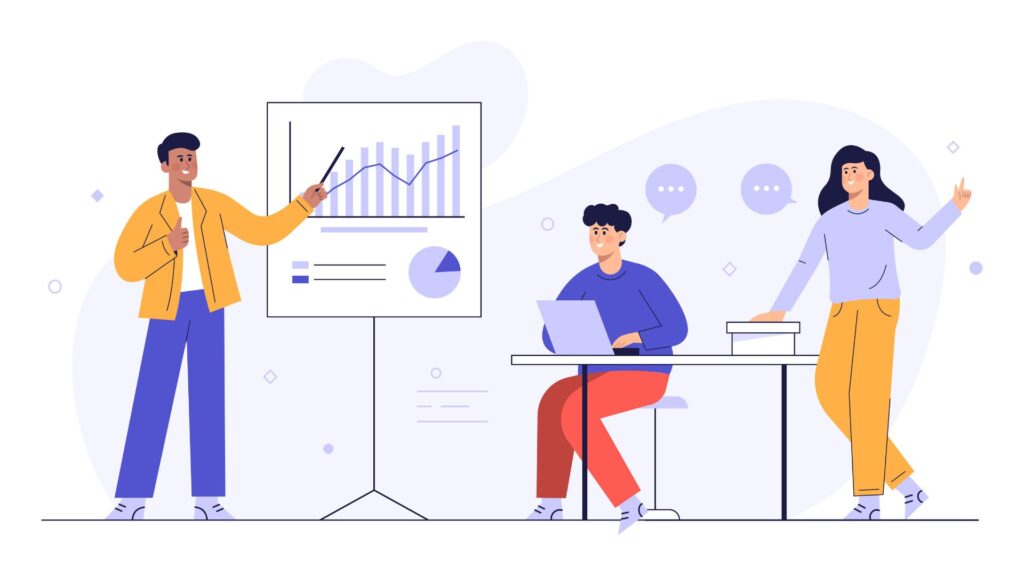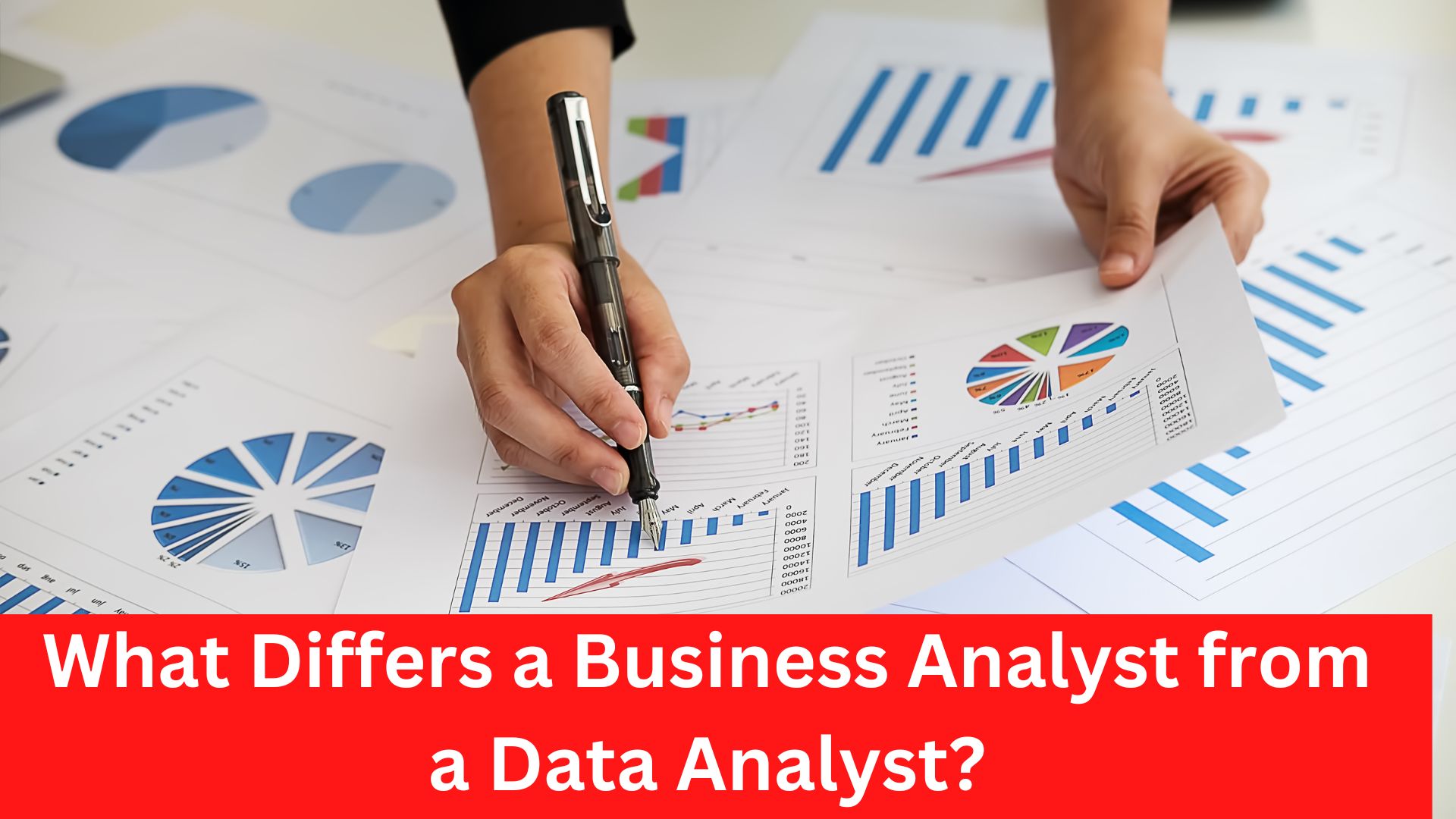Data Analyst vs. Business Analyst: What’s the Difference?
Table of Contents
ToggleA contrast of business analytics and data analytics
Most people concur that the ultimate purpose of business and data analytics is to use technology and data to improve business performance. In a data-driven world where enterprises have access to an exponentially growing amount of information, the two tasks may even cooperate to increase efficiency, provide insightful data, and support the growth of businesses.
The differences between business and data analytics should be more clearly understood as a result of this side-by-side comparison.
Business analyst vs. data analyst: A comparison of roles
Both data analysts and business analysts use data. What they do with it is what makes a difference. Data is used by business analysts to make strategic business decisions. Data analysts acquire data, process it, extract information that is helpful, and distil their findings into easily understandable insights. Their final objective is data analysis.
Both roles call for candidates to have a passion for data, an analytical mindset, strong problem-solving abilities, and the capacity to see and work toward the greater picture. But it’s equally crucial to know how these two professional routes differ if you’re trying to choose between them.
While data analysts need strong business intelligence and data mining abilities as well as expertise with in-demand technologies like machine learning and AI, business analysts must be skilled in modelling and requirements gathering.
A strong foundation in business administration is a major asset for business analysts. Business management, business, IT, computer science, and other related subjects are the backgrounds of many business analysts. On the other hand, data analysts need to grasp intricate statistics, algorithms, and databases, so they would benefit from having a background in math or information technology.
An intro to business analytics
Business analytics (BA) is the iterative exploration of an organization’s data with the goal of revealing information that can help drive innovation and financial performance. Analytics-driven businesses view big data as a valuable corporate asset that fuels business planning and supports future strategies, and business analytics assists them in extracting the most value from this goldmine of insights.
Business analytics can be classified into three types: descriptive, predictive, and prescriptive. These are typically implemented in stages and, when combined, can answer or solve almost any question or problem that a company may have.
Descriptive analytics provides an answer to the question, “What happened?”
- “This type of analytics examines historical data to gain insights into future planning.” Because self-service data access and discovery tools and dashboards are widely available, executives and non-technical professionals can benefit from big data insights to improve business performance.
- The next step on the path to insight is predictive analytics. It employs machine learning and statistical techniques to assist businesses in predicting the likelihood of future events. However, because predictive analytics is probabilistic in nature, it cannot predict the future; it can only suggest the most likely outcome based on past events.
- Prescriptive analytics investigates potential actions based on descriptive and predictive analysis results. This type of analytics combines mathematical models and business rules to optimise decision making by recommending multiple responses to various scenarios and tradeoffs.
Most commonly-used data analysis techniques have been automated to speed the analytical process. Thanks to the widespread availability of powerful analytics platforms, data analysts can sort through huge amounts of data in minutes or hours instead of days or weeks using:
The majority of regularly used data analysis procedures have been automated in order to speed up the analytical process. Because powerful analytics tools are widely available, data analysts can go through massive amounts of data in minutes or hours rather than days or weeks using:
Data mining is the process of searching through enormous data sets in order to uncover trends, patterns, and relationships.
Predictive analytics collects and analyses historical data to assist firms in responding properly to future events such as customer behaviour and equipment problems.
Machine learning: The use of statistical probability to educate computers to process data more quickly than traditional analytical modelling.
Data mining, predictive analytics, and machine learning methods are used in big data analytics to translate data into business intelligence.
Text mining is the detection of patterns and sentiments in papers, emails, and other text-based content.
Data Analyst VS Business Analyst
Data Analyst | Business Analyst |
focuses on digging into and understanding vast datasets in order to find insights and trends. | Focuses on comprehending corporate processes and finding areas for development |
Collects, cleans, and prepares data for analysis. | Assembles and records business requirements obtained from key players. |
Utilizes statistical and data analysis techniques to identify trends and make data-driven recommendations. | Applies business analysis techniques to develop strategies and solutions for business challenges |
Works primarily with quantitative data and employs tools like SQL, Python, or R for analysis | Works with qualitative and quantitative data, using tools like flowcharts and diagrams for process analysis. |
locates data sources, performs data quality evaluations, and guarantees data accuracy. | performs gap analysis, confirms alignment with business goals, and validates the business needs. |
develops reports and visualization’s to effectively convey findings. | creates documentation such as user stories and business requirement documents. |
collaborates with stakeholders to grasp their analytical needs and provide practical information. | Collaborates with stakeholders to understand business goals and provide solutions for process improvement. |
Develops predictive models and conducts forecasting to support strategic decision-making. | Facilitates requirements gathering sessions and leads discussions with stakeholders. |
implements data-driven strategies to enhance productivity and business processes. | Implements business process improvements and supports change management initiatives |
helps with data management and governance tasks to keep data integrity. | Assists in identifying and analyzing business risks and proposing risk mitigation strategies. |
understand how to present data visually using tools like Tableau, Power BI, or matplotlib. | Proficient in business analysis tools like Microsoft Visio or Enterprise Architect for process mapping and modeling. |
concentrates on the technical components of data analysis, such as data extraction, transformation, and loading (ETL) | focuses on comprehending and converting into technical specifications the functional needs of a system. |
Monitors and tracks key performance indicators (KPIs) to measure the success of data-driven initiatives. | Assesses and monitors key performance indicators (KPIs) to measure the effectiveness of business processes. |
Conducts exploratory data analysis to identify trends, outliers, and correlations within datasets. | Conducts business process analysis to identify bottlenecks, inefficiencies, and opportunities for improvement. |
To ensure data accessibility and model quality, actively collaborate with data engineers and data scientists. | To guarantee that system requirements are satisfied and solutions are effectively deployed, collaborates with IT teams and stakeholders. |
gives information on market trends, consumer behaviour, and product performance. | provides information on market opportunities, company strategy, and competition assessments. |
uses A/B tests and data-driven experiments to put changes to the test. | supports process reengineering activities and business process improvement initiatives. |
keeps abreast of the most recent technologies, techniques, and market trends in data analysis. | keeps up with the most recent frameworks, techniques, and best practises in business analysis |
as well as good programming, statistical, and analytical abilities. | Can transition into roles like Product Manager, Project Manager, or Systems Analyst with additional training and experience. |

Data Analyst 10 POINTS
1.Data Analysis:
ability to analyse massive datasets, spot trends, and draw out valuable insights to support data-driven decision-making.
2.Data Manipulation:
knowledgeable about the collection, cleaning, and conversion of raw data into formats that may be used, such as SQL, Python, or R.
3.Statistical Analysis:
knowledge of how to use statistical methods to help decision-making processes, including regression analysis and hypothesis testing.
4.Data Visualization:
ability to effectively convey findings to stakeholders by using technologies like Tableau, Power BI, or matplotlib to create visually appealing and educational data visualisations.
5.Data Quality Assurance:
able to assure data veracity, conduct data quality evaluations, and use data governance procedures to maintain data integrity.
6.Problem-Solving:
To identify difficult business problems, create hypotheses, and extract practical solutions based on data analysis, you need strong analytical and critical thinking skills.
7.Business Acumen:
Understanding of business goals and procedures makes it possible to translate data insights into actionable suggestions for process optimisation and strategic decision-making.
8.Programming Skills:
able to construct effective queries, automate data processes, and carry out sophisticated data analysis. Proficient in programming languages such as Python, SQL, or R.
9. Tools and Technologies:
the capacity to quickly learn new technologies and software, as well as familiarity with data analysis and visualisation tools like Excel, Tableau, Power BI, or Google Analytics.
10.Communication and Collaboration:
Strong interpersonal and communication abilities are necessary to work productively with cross-functional teams, convey findings to non-technical audiences, and succinctly explain difficult data concepts.
.

Business Analyst 10 POINTS
1.Business Requirements Gathering:
capable of conducting seminars, surveys, and interviews to elicit and document comprehensive business requirements from stakeholders.
2.Process Analysis:
capable of analysing and describing existing business processes, locating pain points, bottlenecks, and potential development areas.
3.Stakeholder Collaboration:
Strong ability to work together with stakeholders across departments to comprehend their wants, close communication gaps, and guarantee that provided solutions are aligned with business goals.
4.Business Process Modeling:
knowledge of how to develop process flowcharts, diagrams, and models that represent current and future business processes using software like Microsoft Visio or Enterprise Architect.
5. Requirement Documentation:
able to clearly and concisely document business requirements, user stories, use cases, and functional specifications.
6. Problem-Solving:
Strong analytical and problem-solving abilities to recognise business issues, analyse their causes, and put forth creative solutions that are in line with organisational objectives.
7.Change Management:
a working knowledge of change management principles and the capacity to influence organisational change by convincing stakeholders of the advantages and effects of suggested solutions.
8.Data Analysis:
Ability to work with data to find trends, correlations, and insights that help business decision-making. Basic understanding of data analysis concepts.
9.Business Case Development:
knowledgeable about creating business cases that detail the costs, advantages, and risks connected with suggested solutions, assisting stakeholders in making decisions.
10.Communication and Presentation:
Excellent communication and presentation skills to convey complex information, facilitate meetings, and deliver impactful presentations to both technical and non-technical audiences.
In summary
Data Analytics is about examining data to find patterns and insights.
Business Analytics takes those insights and applies them strategically to achieve specific business objectives.
Analogy:
Think of data analytics as a detective analyzing clues at a crime scene (data) to understand what happened. Business analytics is like the police chief using that information to make decisions on how to improve overall crime prevention strategies.
In essence, data analytics is about understanding the “what,” and business analytics is about understanding the “so what” and “now what” in a business context.
Business analytics primarily focuses on applying data-driven insights to solve specific business problems and improve decision-making. Data analytics, on the other hand, is more centered on processing and analyzing data to uncover patterns, trends, and relationships.
Business analytics aims to provide actionable recommendations for addressing business challenges, while data analytics aims to extract insights from data without necessarily prescribing specific actions.
Business analytics often uses a problem-centric approach, focusing on answering specific business questions using data. Data analytics takes a more exploratory approach, seeking patterns and correlations in data that may not have a predefined question.
While both can involve predictive modeling, data analytics tends to have a stronger emphasis on forecasting future trends and outcomes, as it seeks to uncover patterns that can lead to predictions.
Business analytics directly influences managerial decisions by providing actionable insights and recommendations for specific business problems. Data analytics provides insights that can inform decision-making but might not necessarily prescribe specific actions.

